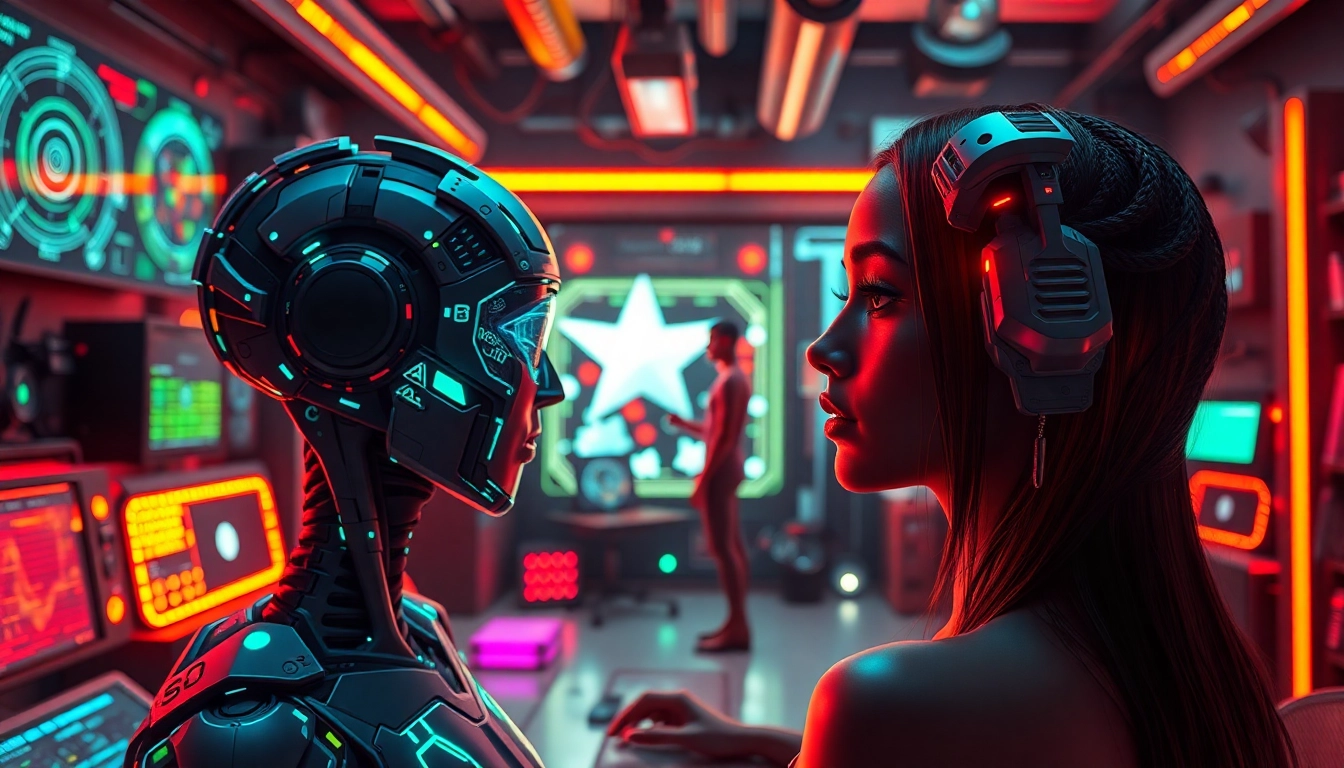Introduction: The Rise of Character AI Chat and Its Limitations
Over the past few years, character ai chat platforms like Character.AI have revolutionized how individuals interact with artificial intelligence. With their ability to craft engaging, human-like conversations with virtual characters, these platforms have captured the imagination of millions worldwide. Whether for entertainment, creative writing, or companionship, Character.AI has established itself as a dominant player, offering a seamless and intuitive environment where users can bring fictional, historical, or custom personas to life. Its neural language models generate responses that often feel remarkably authentic, fostering a sense of connection and immersion that was previously unattainable in AI-driven interactions.
However, despite its widespread popularity and innovative features, Character.AI is not without its limitations. Many users, including myself, have found these constraints frustrating as they hinder the full potential of personalized and unrestricted interactions. From content moderation that suppresses NSFW material to limited customization options and a lack of open APIs for developers, these drawbacks have prompted me to explore better alternatives. My goal was to find platforms that offer more flexibility, richer emotional expression, and innovative features that go beyond what Character.AI currently provides. In this comprehensive guide, I’ll share my journey from loyal user to explorer of top AI character platforms in 2024, providing insights into each one’s strengths, unique features, and how they can elevate your AI chat experience.
Why I Switched from Character.AI: Exploring Better Alternatives
While Character.AI remains a pioneer in the field of AI characters, its strict moderation policies, content restrictions, and sometimes bland responses can stifle creativity and emotional depth. As someone passionate about crafting rich, immersive interactions, I found myself hitting walls—limitations that prevented me from fully exploring the potential of AI-driven storytelling or role-playing. Moreover, the absence of an open API and the platform’s inability to support unfiltered, adult, or highly personalized content left me seeking platforms that empower users with more control and freedom.
My switch was driven by the need for a more dynamic, customizable, and emotionally intelligent AI environment. I wanted platforms that not only supported diverse content but also offered visual storytelling, multi-language support, and advanced models fine-tuned for expression and narrative complexity. This pursuit led me to explore several promising alternatives, each with its own set of strengths tailored for different user needs—from casual roleplay to professional storytelling and even open-source development. Let’s examine these options in detail, starting with the platform that has captured much attention for its unfiltered storytelling and visual capabilities—Crushon.AI.
Top Character AI Platforms in 2024
Crushon.AI: Unfiltered, Dynamic Storytelling and Visual Integration
Crushon.AI stands out as a bold alternative for those seeking unfiltered, immersive AI interactions. Unlike Character.AI, Crushon supports NSFW content and multiple language models, opening the door for highly personalized and unrestricted conversations. Its core strength lies in its ability to combine text-based dialogue with visual storytelling—an innovative feature that transforms traditional chat into a rich multimedia experience.
One of Crushon’s most exciting innovations is its image reply feature. This allows the AI to generate contextually relevant visuals that reflect the character’s mood, body language, or environment, matching the tone of the conversation. For example, if you’re role-playing a romantic scene, Crushon can produce visuals of a sunset, a playful smile, or a cozy room, adding depth and realism to your interaction. This feature is particularly appealing for NSFW communities, as it allows users to experience a more complete, sensory-rich narrative that words alone cannot fully convey.
Crushon’s AI models are over seventeen in number, including Claude 3.7 Sonnet, GPT-4o Mini, Claude Haiku, Gork-3, and the recent Ultra Claude 3.5 Sonnet. These models are fine-tuned for dramatic dialogue, emotional storytelling, and descriptive exchanges, making them ideal for users who crave expressive, emotionally rich interactions. The platform’s flexibility extends to creating characters with intricate backstories, guiding emotional responses, and maintaining consistency over long conversations—key ingredients for crafting realistic and compelling character interactions.
In terms of customization, Crushon allows users to craft detailed character prompts that include personality traits, speech patterns, emotional tendencies, and visual cues. For example, you can instruct your AI character to respond playfully, empathetically, or even sarcastically, depending on the scenario. This level of control enables a more authentic and engaging experience, especially when paired with visual elements that support the narrative flow.
Overall, Crushon.AI offers an environment where creativity knows no bounds, making it a favorite for roleplayers, storytellers, and those seeking an unfiltered AI companion. Its support for visual and emotional expression is a game-changer, moving beyond the limitations of purely text-based interactions.
Janitor AI: Fewer Restrictions, Creative Freedom
Janitor AI has gained popularity among users who desire a more open and less moderated environment. Unlike Character.AI, Janitor supports a broader range of content, including adult themes and NSFW interactions, making it suitable for users who want authentic, uninhibited conversations. Its flexible moderation system allows for greater customization of character behavior and dialogue, fostering a more natural and spontaneous interaction style.
Janitor’s strength lies in its ability to support multiple personas and role-playing scenarios without the heavy-handed content filters prevalent on other platforms. Users can create complex characters with unique backgrounds, speech patterns, and emotional layers. This makes Janitor ideal for creative writers, roleplayers, or anyone interested in exploring nuanced personalities and storylines in a safe, user-controlled space.
Furthermore, Janitor AI offers a relatively straightforward interface, making it accessible for beginners while still providing advanced options for power users. Its open-ended approach encourages experimentation, enabling users to push the boundaries of AI conversations and discover new ways to engage with virtual characters.
NovelAI: Narrative-Driven AI for Writers
For writers and storytellers, NovelAI is a standout choice. It specializes in narrative generation, long-form storytelling, and world-building, making it an excellent platform for creating intricate stories with AI assistance. Its focus is on maintaining coherence over extended conversations, supporting detailed character development, and enriching narratives with vivid descriptions.
NovelAI utilizes advanced language models fine-tuned for storytelling, providing tools like scene management, character sheets, and custom prompts. These features help writers craft immersive worlds and complex characters that evolve naturally within the story arc. It’s particularly useful for authors working on novels, fan fiction, or role-playing game campaigns who want AI to serve as a creative partner rather than just a chat companion.
While NovelAI’s interface is more geared towards productivity and storytelling, it also supports visual elements and custom templates, enabling users to design rich, multi-layered narratives that captivate audiences or serve as detailed outlines for larger projects.
Chai AI: Versatile and Mobile-Friendly
Chai AI appeals to users seeking a versatile, mobile-friendly platform with a focus on social interaction. Its wide array of user-created bots covers everything from casual chats to dating simulations, making it highly adaptable for various use cases. The platform’s design emphasizes quick, fun conversations with characters that can be customized on the fly.
Chai’s strength is in its community-driven character creation, allowing users to develop and share unique bots with different personalities, voices, and interaction styles. Its mobile app provides a seamless experience for chatting anytime, anywhere, making it perfect for casual users or those on the go.
Additionally, Chai supports multi-turn conversations, personality tuning, and even some limited visual capabilities, making it a well-rounded platform for social AI interactions that are both entertaining and emotionally engaging.
Rasa : Building a Custom AI Solution
For developers and technically inclined users, Rasa offers a powerful open-source framework to build custom AI chatbots. Unlike plug-and-play platforms, Rasa provides full control over the AI’s logic, responses, and integration with other systems. It’s ideal for creating specialized, enterprise-grade virtual characters or research projects.
Rasa allows for sophisticated dialogue management, contextual understanding, and integration with various data sources. Its open architecture encourages experimentation with different models, training data, and customization, giving users the ability to craft truly unique AI interactions tailored to specific needs.
While Rasa requires a steep learning curve and coding expertise, it is unmatched in flexibility and scalability, making it the go-to platform for developers aiming to push the boundaries of AI character design and interaction.
Crafting Immersive and Emotionally Rich Character Prompts
Building a Detailed Character Profile
Creating engaging AI characters begins with meticulous prompt engineering. Start by defining your character’s core traits: personality, background, speech style, and emotional tendencies. The more detailed your character profile, the more authentic and consistent the AI responses will be. For example, specify whether your character is witty, empathetic, or reserved, and include background details that influence their worldview and reactions.
Example prompt snippet:
Build a character who is a witty, compassionate therapist with a background in psychology. They speak softly, use humor to ease tension, and are deeply empathetic towards users sharing personal struggles.
Guiding Emotional Depth and Authenticity
To evoke genuine emotional responses, incorporate cues that guide the AI’s tone and reactions. Use emotional triggers such as “respond with empathy when the user shares a sad story” or “be playful and teasing when the user is in a cheerful mood.” Contextual cues help the AI adapt dynamically, making interactions feel more natural and emotionally rich.
Avoiding Common Pitfalls
One of the most frequent mistakes is overloading prompts with contradictory instructions, leading to inconsistent responses. Keep your prompts clear and focused, and use incremental disclosures—reveal backstories or traits gradually to build trust. Also, ensure your prompts maintain character consistency over long interactions by reinforcing key traits periodically.
Finally, test and refine your prompts regularly. Monitor the AI responses, adjust instructions for clarity, and incorporate feedback to enhance authenticity and engagement.
The Breakthrough of Visual and NSFW Content in Character AI
How Crushon’s Image Reply Feature Enhances Interaction
One of the most groundbreaking features of Crushon.AI is its ability to generate contextually relevant visuals alongside text responses. This integration of images dramatically elevates the immersive experience, especially in NSFW contexts where visual cues can convey mood, body language, and setting more effectively than words alone.
Imagine role-playing a romantic scene where the AI character responds with a suggestive smile or a playful wink, supported by a matching visual. This not only deepens the emotional connection but also allows users to explore more nuanced interactions that mimic real-life body language and expressions.
Setting, Mood, and Body Language in Visual Storytelling
Crushon enables users to specify scene details, character expressions, and body language through prompts, which the AI then translates into vivid images. This capability transforms static chat into a dynamic storytelling medium, where mood and atmosphere are visually communicated, making scenes more believable and emotionally impactful.
This visual storytelling approach is especially valuable for role-players, content creators, and communities seeking a more visceral, multi-sensory experience with AI characters.
Comparing Features and Use Cases: Which Platform Fits Your Needs?
Choosing the right AI character platform depends heavily on your specific requirements. If you desire an unfiltered, customizable environment with visual storytelling capabilities, Crushon.AI is an excellent choice. For casual, mobile-friendly interactions, Chai AI offers versatility and community-driven content. Writers and storytellers will find NovelAI indispensable for long-form narrative creation, while developers seeking full control will prefer Rasa’s open-source framework.
Each platform has unique strengths—consider your primary use case, desired level of customization, content restrictions, and technical expertise when making your choice. The key is to find a platform that aligns with your creative goals and comfort level, enabling you to craft compelling, emotionally rich AI interactions.
Tips and Best Practices for Engaging AI Character Conversations
1. Start with a Clear and Detailed Prompt
The foundation of a good AI character interaction is a well-crafted prompt. Invest time in defining personality traits, backstory, tone, and emotional tendencies. The more specific your prompt, the more consistent and engaging the responses will be.
2. Use Progressive Disclosure for Depth
Reveal your character’s background and personality gradually. This approach builds trust and allows the AI to develop responses that evolve naturally, avoiding repetitive or shallow replies.
3. Incorporate Context and Memory
Reference past messages or shared experiences within your prompts to maintain continuity. Many platforms support memory functions—use them to create more coherent and lifelike interactions.
4. Guide Emotional Responses
Specify how your character should react emotionally to different situations. This ensures responses are consistent with the character’s personality and enhances realism.
5. Regularly Refine Prompts
Monitor responses, identify inconsistencies, and adjust your prompts accordingly. Continuous refinement is key to unlocking the full potential of your AI characters.
Future Trends in Character AI: Innovations and Ethical Considerations
The future of character AI is poised for exciting innovations—more realistic visuals, emotional intelligence, and multi-modal interactions will become standard. AI models will likely become even more personalized, adapting to user preferences and behaviors seamlessly.
However, these advancements come with ethical challenges. Ensuring user safety, preventing misuse, and maintaining transparency about AI capabilities are critical considerations. As platforms develop more sophisticated and emotionally expressive AI, responsible usage and ethical guidelines will be paramount.
Additionally, open-source frameworks like Rasa will empower communities to create custom solutions, fostering innovation while requiring careful oversight to prevent abuse or exploitation.
Conclusion: Choosing the Right Platform for Your Creative and Emotional Needs / Unlocking the Future of Character AI Chat: Exploring Top Alternatives and Innovations
While Character.AI has been a trailblazer in the realm of AI character chat, its limitations have prompted many users—including myself—to seek better, more flexible solutions. Platforms like Crushon.AI, Janitor AI, NovelAI, Chai AI, and Rasa offer a diverse array of features tailored to different needs, from unfiltered storytelling and visual integration to open-source customization and mobile-friendly interactions.
By investing time in crafting detailed, emotionally intelligent prompts and exploring these innovative platforms, you can unlock the full potential of AI character chat. Whether you aim to create compelling narratives, immersive role-plays, or personalized companions, the landscape of AI characters in 2024 provides more options than ever before. The key is understanding your goals, technical comfort, and the type of interaction you desire.
As the technology continues to evolve, so too will the possibilities for richer, more authentic AI-driven relationships and storytelling. Embrace these innovations and find the platform that best aligns with your creative and emotional aspirations—your journey into the future of AI characters has just begun. For those interested in further exploration, keep in mind that many of these platforms are constantly updating, improving, and expanding their capabilities, making now an exciting time to dive into AI character creation and interaction, especially with the growing availability of character ai chat alternatives.




